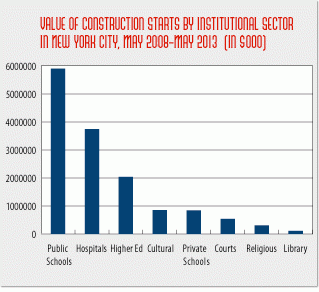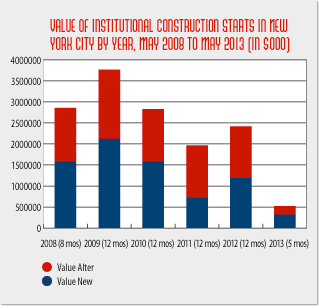
New york city institutions responsible for $14.8 billion in construction starts over five year period
Public Schools Accounted for 40 Percent of All Construction Starts by Value, Followed by Health and Hospitals Sector at 25 Percent
New York City’s public and private institutions initiated $14.8 billion in construction projects over a five year period from June 2008 through May 2013, according to a New York Building Congress analysis of McGraw Hill Construction Dodge data.
The data encompass all recorded project starts, including new construction as well as alterations and renovations to existing structures, and reflect the estimated value of each initiated project through the entire period of construction. The sectors examined include elementary and secondary schools, hospitals and health care, higher education, courts, libraries, cultural facilities and religious institutions.
From June 2008 through May 2013, educational facilities accounted for 61 percent, or $8.9 billion, of all construction starts (by value) among public and private institutions operating in New York City.
Public elementary and secondary schools alone accounted for $5.9 billion (40 percent) in construction starts, while public and private colleges and universities produced $2.2 billion in new projects. Private elementary and secondary schools initiated an additional $845 million in new projects.
“Lost in the recent discussion of Mayor Bloomberg’s legacy are his great achievements in repairing, modernizing and expanding New York City’s public schools,” said New York Building Congress President Richard T. Anderson. “Undeniably, the Mayor has left the physical condition of our schools in far better condition than he found them 12 years ago.”
Looking beyond education, public and private hospitals and healthcare facilities accounted for $3.7 billion (25 percent) of all institutional construction starts by value during the five-year period. Cultural facilities were responsible for another 8 percent ($1.1 billion) of all initiated projects. Court facilities, religious institutions and libraries each contributed less than 4 percent of all institutional construction starts by value between June 2008 and May 2013.
Mr. Anderson added, “The past five years have been defined by the Great Recession and the economic malaise that followed in its wake. Yet even in these tough economic times, the City’s education, healthcare and cultural institutions have demonstrated their confidence in the City’s future by continuing to invest heavily in their physical buildings and campuses.”
The Building Congress analysis also yielded the following findings.
Top Projects
While education dominated in terms of volume of work and overall value, the top project list was led by medical and scientific research facilities, which took five of the top seven spots. The top five projects, by value, from the past five years were the Weill Cornell Biomedical Research Building, the Javits Convention Center expansion, the CUNY Advanced Science Research Center, the East River Science Park West Tower and the new Whitney Museum of American Art.
2013
A total of $525 million in institutional projects began during the first five months of 2013, which is up slightly from $517 million in construction starts for the same period in 2012. These totals are considerably below the $1.1 billion in construction starts achieved in the first five months of both 2010 and 2011. The numbers for the first halves of 2010 and 2011 were bolstered considerably by the initiation of a few major projects, including the Weill Cornell building in 2010, and both the new Whitney museum and a Columbia University research facility in 2011.
Employment
New York City’s public and private institutions employed 732,00 people in 2012, up from 719,000 people in 2011 and 711,000 in 2010. Total employment by New York City’s institutions has risen annually since at least 1990.
New vs. Renovated
Approximately 53 percent of the projects initiated over the past five years have been for ground-up construction of new facilities. The remaining 47 percent were renovations and alterations to existing structures.
Mr. Anderson concluded, “Looking ahead, the Building Congress projects continued strength in the institutional sector. In addition to New York’s public schools, the City’s colleges and universities, particularly, are poised for growth, thanks in large part to Columbia University’s Manhattanville expansion, New York University’s NYU 2031 plan, and the creation of Cornell University’s CornellNYC Tech campus on Roosevelt Island.”
Charts and Diagrams

Source: McGraw Hill Construction Dodge*

Source: McGraw Hill Construction Dodge*

Source: New York State Department of Labor
* Dodge data used for this analysis can be purchased at dodge.construction.com



